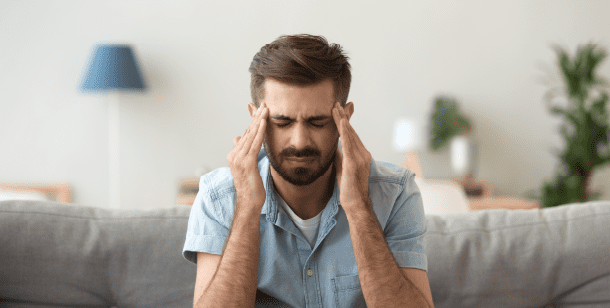Though cluster headaches are one of the most painful types of headaches, very little is known about them. People with cluster headaches may often find themselves wondering, “how long do cluster headaches last?” because the pain is excruciating and they want them to end as quickly as possible. In this article, we will discuss the potential causes, common symptoms, and available treatments for cluster headaches and help you determine the right time to seek out medical help.
What is a Cluster Headache?
Cluster headaches are primary headaches, meaning that the headache itself is the main issue and the pain is not originating from a different underlying cause. They consist of the cyclical onset of sudden, intense pain, usually behind the eye, and they affect one side of the head for several hours at a time. This pain can radiate to other parts of the head, face, neck, shoulders, temple, cheek, jaw, teeth, or nose, usually localizing on that same side of the body.

What Causes Cluster Headaches?
The underlying cause behind cluster headaches is largely unknown. Because cluster headaches are so rare, affecting only 1 person out of 1,000, it is difficult to conduct a proper research study in an attempt to learn more.
One theory states that cluster headaches have to do with the body’s sudden release of histamine, or possibly serotonin. Another states that the hypothalamus and the trigeminal nerve pathway might be involved, resulting in dilated blood vessels sending more blood to the brain and causing pain.
Despite the lack of concrete research involving cluster headaches, physicians have managed to catalog commonalities among those who suffer from cluster headaches.
Cluster headaches often:
- Occur around the same time each day, mostly during the late afternoon and evening.
- Impact more men than women, with six out of every 10 patients being male.
- Are more likely to affect someone who smokes.
- Are most likely to occur in patients over the age of 20.
- Are more common in the fall and spring.
Triggers
Potential triggers for a cluster headache include:
- Alcohol
- Rising Temperatures
- Exercise in Hot Weather
- Odors (Perfume, Solvents, etc.)
- Irregular Sleep Patterns
- Certain Foods
- High Altitudes
- Bright Light
- Stress
- Anxiety
- Depression
- Hormone Changes
- Caffeine
- Loud Noises
- Certain Medications
- Cocaine Use
Studies have also linked smoking, allergies, and genetics to more frequent cluster headaches.
Symptoms of Cluster Headaches
Cluster headaches are characterized by intense pain that starts rapidly and without warning. This pain is continuous in nature, rather than throbbing. Patients often describe the pain of a cluster headache as “stabbing,” “sharp,” “burning,” and “knifelike,” and many patients have reported that the pain can sometimes be strong enough to wake someone from sleep.
Patients have also reported symptoms before cluster headaches occur. These symptoms include but are not limited to:
- Changes in Mood
- Yawning
- Food Cravings
Symptoms of an active cluster headache can include:
- Restlessness
- Redness, swelling, or watering of the affected eye
- Stuffy, blocked, or runny nose on the affected side of the face
- Pale skin
- Facial sweating
- Small pupils
- Drooping of the affected eyelid
It is common for patients to feel tired and drained after the headache has ended.
How Long Can Cluster Headaches Last?
Cluster headaches occur cyclically, which is what makes them unique. They can occur randomly up to 8 times a day, starting suddenly and lasting anywhere from 15 minutes to three hours.
As the first one occurs, patients enter “cluster periods,” or periods of time where the headaches will continue to occur. Cluster periods can last for a few days, or from weeks to months, but usually span roughly 6 to 12 weeks. These headaches often occur around the same time each day and most often occur at night.
People who suffer from cluster headaches will often enter remission periods where they will experience no headaches, and be pain-free for an extended period of time. These remission periods can last for months or years.
Cluster headaches can be broken down into two different categories: Episodic Cluster Headaches and Chronic Cluster Headaches.
Episodic Cluster Headaches
Episodic cluster headaches are defined as a series of headaches lasting from one week to three months, with extended remission periods.
Chronic Cluster Headaches
Chronic cluster headaches are defined as a cluster period that persists for several months to one year, or longer, with short remission periods.
Cluster Headache vs. Migraine
Both of these headaches can be extremely painful, however, they manifest differently from one another. Here are the main differences.
Migraine
Migraines are characterized by the presence of visual disturbances, such as flashing lights or zigzag lines. They can last up to 72 hours and tend to involve nausea, vomiting, and sensitivity to light. Patients often find that laying down during a migraine can help alleviate symptoms. Patients suffering from migraines often prefer stillness and reduced stimulation.
Cluster Headaches
Cluster headaches start and end suddenly and are much shorter in duration. They tend to affect only one side of the head, and laying down may worsen the pain. Patients dealing with cluster headaches may rock back and forth during an attack, hold their heads in their hands, or get up and walk, as movement can help distract from the pain.

How to Prevent Cluster Headaches
There is currently no cure for cluster headaches, so treatment options focus on prevention, alleviating symptoms, and attempting to diminish the intensity and frequency of attacks.
Quick Responses:
At the onset of a cluster headache, the following things can act as a quick response to treating symptoms and diminishing pain:
- A High Dose of 100% Oxygen
- Sumatriptan
- Dihydroergotamine
- Octreotide
- Local Anesthetic
- Nasal Spray or Drops
Short Term Treatments:
To prevent recurrent attacks, these short term treatment options may be used:
- Corticosteroids
- Ergotamine
- Anesthetic on the Occipital Nerve
Long Term Treatments:
These long term treatment options may help reduce the frequency of cluster headaches:
- Calcium Channel Blockers
- Lithium Carbonate
- Anti-Seizure Medications
Read this article for a more in-depth look at each of these treatments, or speak with your primary care physician for more information.
Despite there being no cure for cluster headaches, there is a silver lining! These headaches, while painful, are not life-threatening and cause no permanent changes or damage to the brain. Though these headaches last for long periods of time, they occur less frequently with age.
When to Get Help for Cluster Headaches
You should not have to live with chronic intense pain. If you feel that cluster headaches are causing you to experience the “worst pain of your life,” reach out to a medical professional for help.
It will help your physician if you are able to provide documented details about your cluster headaches. The more information you can provide about your symptoms, triggers, and frequency, the better equipped your doctor will be to help you.
Seek help for cluster headaches immediately if:
- You experience issues with speech, vision, movement, or loss of balance.
- The patterns or intensity of the headaches change.
- Active treatments no longer help.
- You experience negative side effects from active treatments.
- You are pregnant or could become pregnant, as some medications are not good for pregnancy.
- Your headaches become worse when lying down.
- You experience neck stiffness with your headache.
With a Village Behind You
If you suffer from cluster headaches, we hope you know you’re not alone. Reach out to our team of board-certified physicians to get help alleviating pain and coming up with a long-term treatment plan.

